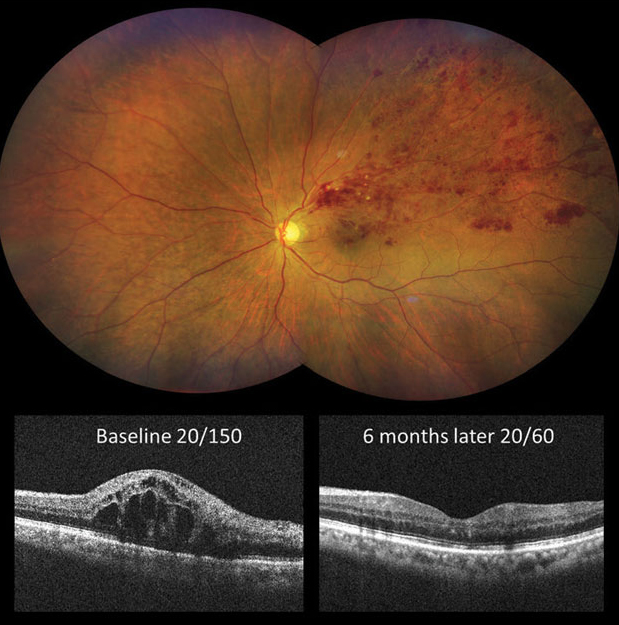 |
| Introducing anti-VEGF treatment with attention to the presence of recurrent serous retinal detachment can help to optimize BVO-ME patients’ visual outcomes. Photo: Carolyn Majcher, OD. Click image to enlarge. |
Because macular edema contributes heavily to visual acuity decline in patients with retinal vein occlusion, clinicians aim to reduce it by treating with anti-VEGF agents. Recently, researchers investigated long-term treatment outcomes in patients with macular edema secondary to branch retinal vein occlusion (BRVO), since data beyond three months was limited. They clarified several predictors of long-term visual prognosis in these patients by correlating retinal structure via optical coherence tomography and visual acuity.
In the single center study, the researchers retrospectively recruited patients who received intravitreal anti-VEGF injections as their primary treatment for BRVO and who had at least 36 months of follow-up. Patients were divided into Groups A (≥0.7) and B (<0.7) based on their best-corrected visual acuity (BCVA) at the final visit.
A total of 47 eyes of 45 patients were assessed, with mean follow-up of 64.38 months. Group A (n=32) had significantly better BCVA than Group B (n=15) at all time points. The ratio that the number of eyes with intact ellipsoid zone band and foveal bulge in Group A was higher than in Group B. The ratio that the number of eyes with observed serous retinal detachment recurrence by the final visit in Group A was lower than in Group B.
“This study demonstrated that baseline BCVA, the integrity of the ellipsoid zone layer, and the presence of a foveal bulge were significant predictors of post-treatment visual acuity in the long-term, as well as in the short-term, as shown in other studies,” the researchers wrote in their BMC Ophthalmology paper.
Their study also adds important long-term data to a body of previously published literature composed mainly of short-term (less than three year) outcomes. “In contrast to other studies, this study showed that central retinal thickness was not a useful predictor based on long-term observation,” they wrote.
“Although most studies that have a short-term follow-up showed that the presence of serous retinal detachment negatively affected visual prognosis, our long-term analysis showed that the presence of serous retinal detachment at initial presentation did not affect visual prognosis. Still, the presence of recurrent serous retinal detachment did predict a poor visual prognosis.”
Hattori Y, Fujiwara R, Mori H, et al. Treatment strategy for BVO-ME based on long-term outcomes corelating retinal structure by OCT image and visual acuity. BMC Ophthalmology 2023;23:385. |

